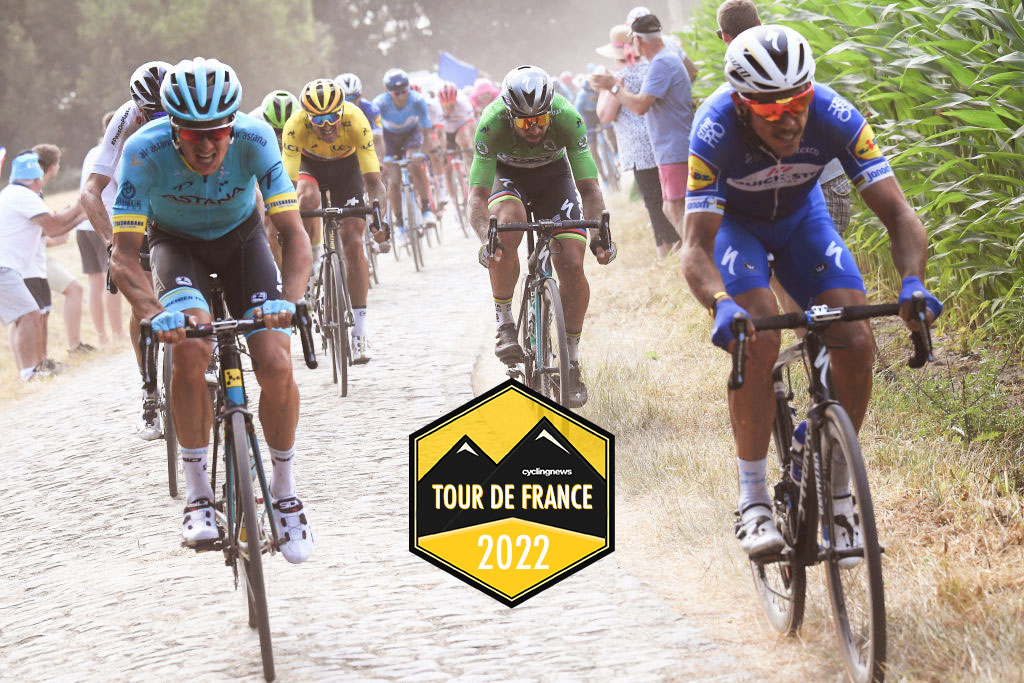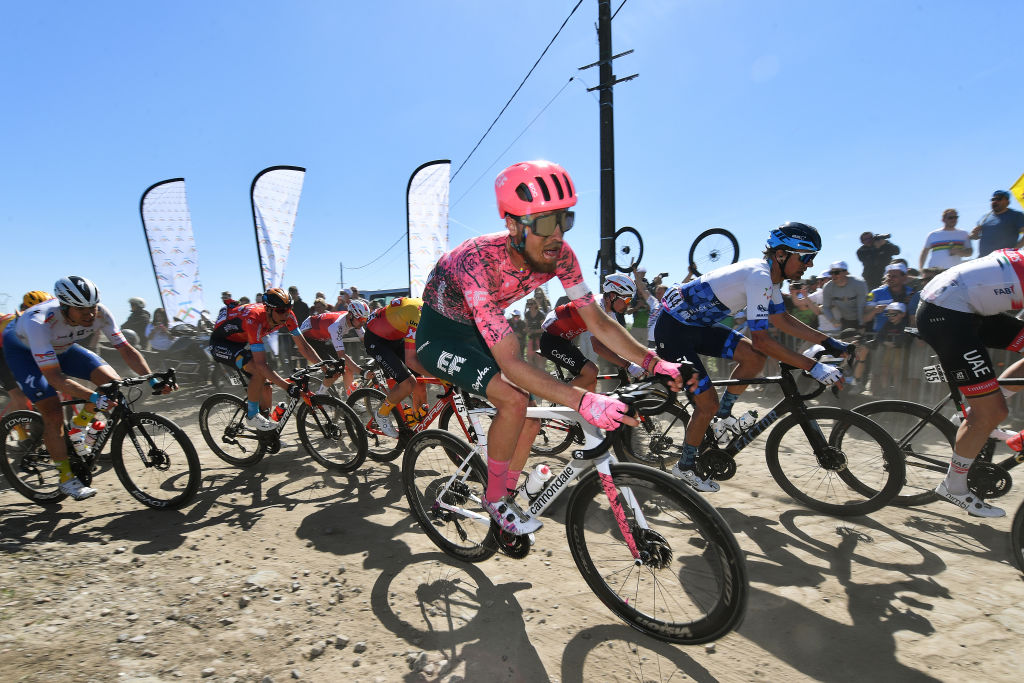All hands on deck - The brutal knock-on effect of a cobbled Tour de France stage
How the stage 5 pavé will affect the 2022 Tour de France racing long-term

Very soon now, the much-anticipated Paris-Roubaix-style stage of the Tour de France will have been completed, and even if this year's peloton is 'only' riding 19. 4 kilometres of pavé, compared to 54.8 kilometres in a regular Hell of the North, the effects could be just as telling.
That's partly because, even if uninjured, after Paris-Roubaix, it can take riders a few days or longer to recover from the physical effects of riding over kilometres of bone-jarring cobbles. However, the Tour de France peloton's form of 'switching off' from their incursion on the pavé will be rather different: a 219-kilometre, five-hour stage on Thursday that is, as it happens, the longest of the entire 2022 Tour.
So it's worth remembering that even if the fallout from the GC battle will be dominating the headlines on Thursday, rather than taking a well-earned break as most riders do post Paris-Roubaix, there will be no escape for any of the riders in the Tour.
The solution? Going into damage limitation mode is one way round it.
"Typically, by common consent, the peloton will have an easier day the stage afterwards," EF Education-EasyPost Head of Physical Therapy, Matt Rabin, told Cyclingnews.
"First of all a lot of the guys in the peloton aren't used to riding the pavé so it'll be interesting to see how they wash up, and on top of that a lot of GC guys are more frail of bone or don't have as much muscle to absorb the rattling. So they'll be more shocked by some of the after-effects of riding the pavé than not.
"So I think on Thursday it wouldn't surprise me if it was one of those days where the peloton decided to allow a break of 6 or 7 clip off up the road, and the rest have a bit of a day off."
Get The Leadout Newsletter
The latest race content, interviews, features, reviews and expert buying guides, direct to your inbox!
The effects of the Roubaix-esque stage are so unpredictable, Rabin said, the idea of an unspoken truce is appealing across the board.
"Physically some guys will be much more beat up than others, and some people's Tour de France will have come to an end, one way or another," he said.
"So this could be the first day we see a break go to the finish, just because there's such a discrepancy between who's beat up and who's not, and who's available to chase them down, or not."
That's in terms of the racing itself. When it comes to physical consequences, Rabin said, even not counting those who have maybe crashed and who are nursing specific injuries, there will be plenty of guaranteed general issues for medical staff to handle as well.
"Physically their backs are going to be sore, hands will be sore, they'll feel shaken up. And hopefully most teams have enough support and care to help them recover for the next day. That's the ultimate goal of every stage of the Tour, but it's just going to be that bit more brutal tomorrow [Wednesday]."
Moderating the stress
Rabin said that even in his decade-and-counting working in cycling, there have been some changes for the better when it comes to handling general cobble-induced physical wear-and-tear. However, some of those changes are more due to indirect improvements in the technical side of the sport when it comes to racing on pavé than for concerns for riders bodies per se.
"One development of the last 10 years is that most teams will be on different material tomorrow: different tyres, different tyre pressures and potentially even different bikes. That can moderate a lot of the stress and strain on the body because slightly wider tyres and less pressure means a more comfortable ride. So the geometry of the Roubaix bikes is generally slightly more forgiving."
Still, when it comes to the rider's own bodies and getting extra protection for Wednesday's journey through the Hell of the North, it's not so straightforward.
"Some riders you might find might get their wrists and backs taped up whereas they wouldn't in normal stages," said Rabin. "But quite a lot of guys don't like extra bits and pieces on a Roubaix stage. A lot of them won't wear gloves, for example, because of that extra layer of rubbing on the skin."
"So there are things that you can do, but generally it's more to do with performance than comfort. On the other hand, there's a lot of stuff that the teams are going to throw at tomorrow's [Wednesday's] stage – extra feeding, extra staff, extra planning. If you were watching from the side of the road ... you wouldn't have a clue that for most teams it's a red-letter day."
The overwhelming attitude, Rabin said, is to treat Wednesday as a one-off that marks the end of one chapter and the start of another. As he puts it, "being so physically brutal, it's a case of 'let's get through tomorrow with the equipment, the support, strappings and tapings and then see where we are Thursday.'"
Managing the aftermath

When it comes to anticipating who will be most likely to be on the back foot in terms of physical wear and tear generally, Rabin said it's a much more complicated equation than simply the better you're built for it, the less damage you'll suffer.
"It's a difficult question to answer, but the guys who do the Classics are much better at it, and therefore the effects on them will be a lot less. And that's why you saw a lot of GC guys doing the cobbled Classics during the early part of the year, just to understand and get the feel for how to do it. On the other hand, the smaller guys will more likely get pinged around a bit, but also they're less likely to have as good a feel as the Classic guys for the racing, anyway."
This has potentially massive implications, because the damage-versus-practice equation skews disproportionately badly against those whose knowledge of cobbled racing is limited. For a lightly built non-specialist, even a comparatively small drop in skill levels and knowledge of cobbled races can have a major knock-on effect in terms of physical wear and tear and a little experience can pull that back, considerably.
Yet for all that, the night before the cobbled stage, Rabin said, there is no sense of stress running higher than usual in the Tour hotels. Few of the GC riders are expected to be able to get a result rather than just getting through, with Geraint Thomas (Ineos Grenadiers), once 7th in Roubaix, arguably the exception to that particular rule and victory is generally reduced to "the three or four Classics guys present who have limited GC responsibilities."
However, and perhaps contrary to some people's expectations, it's the aftermath where the stress levels hit the heights. And that's partly, Rabin said, because this show goes on come what may. This is a stage race, not a one-day race, so abandoning is not nearly as easy an option to take as it would be in the event of misfortune in a normal Paris-Roubaix.
"The work for us comes after the stage, because physically they can be so beaten up, it's all hands on deck to get them into good shape again. In Paris-Roubaix, guys crash and they get off. Here they can't so easily, they've got to finish. Often in Roubaix your race can be finished quite quickly. But that's not possible here.
"So that's why the work will come tomorrow: who's banged up, who's pinged up, who's [got a] body that's in bits... who needs what work to get them going again." I
It's not only physical, Rabin said, "because if you're a GC guy and lose two or three minutes in a crash, that's going to be a kick in the teeth because physically that'll hurt. But psychologically that hurts too.
"You need wraparound care from every person with whom there's an interaction to get them going the next day. It's the same as we do every day, and you never know in the Tour de France, sometimes the easiest transition stage becomes the hardest day that you can get, the crosswinds can start to blow and it changes quite quickly. But we'll most likely be doing more tomorrow."
Alasdair Fotheringham has been reporting on cycling since 1991. He has covered every Tour de France since 1992 bar one, as well as numerous other bike races of all shapes and sizes, ranging from the Olympic Games in 2008 to the now sadly defunct Subida a Urkiola hill climb in Spain. As well as working for Cyclingnews, he has also written for The Independent, The Guardian, ProCycling, The Express and Reuters.
